John Hurrell – 4 August, 2024
I'm very aware that one can never second-guess visiting adjudicating judges. It is not at all smart-alecky (and quite realistic) to view the whole process as a bit of a lottery, and that it is extremely unlikely that the works that happen to vehemently push your buttons, will also press those of the judge.
Auckland
Brett Graham, Owen Connors, Ana Iti, Juliet Carpenter
2024 Walters Prize
6 July 2024 - 20 October 2024
This, the eleventh Walters Prize show, is indisputably an exciting occasion for Auckland Art Gallery Toi o Tamaki but—in my opinion—one marred this time by a programming disaster, it being juxtaposed with the new Aotearoa Contemporary (allegedly a sort of triennale). This is because the two projects seem to blend spatially and conceptually as one. It is a shame they are not being presented on separate occasions, to ensure their identities are kept separate so that the different agendas of these very different group shows don’t overlap.
That said, the eleventh Walters Prize line up varies from one extremely experienced artist (used to international residencies) to three others almost unknown even nationally. Personally I think three of the finalists are far superior to the fourth (which I struggle to take seriously), but I’m very aware that one can never second-guess visiting adjudicating judges. It is not at all smart-alecky (and quite realistic) to view the whole process as a bit of a lottery, and that it is extremely unlikely that the works that happen to vehemently push your buttons, will also press those of the judge.
Instead of spotlighting more established artists, it usually tends to focus on introducing new younger talents to Auckland lovers of contemporary art. There is an argument (perhaps dubious) that this helps to keep the project vibrant. However Brett Graham is the most ‘mainstream’ of the contenders—and with Ka Wheeke, his sixteen-sided, colonial warship gun turret, with its gun slots and extraordinary blending of once warring cultures (through its beautifully carved whakairo patterns), is probably the favourite—bearing in mind that comment really has no traction for a non-New Zealand Aotearoa judge. And that the exhibiting (national and international) experience of the artists through their four practices is countered by the experiential that the adjudicator takes on within the Tāmaki Makaurau Auckland space.
Whatever the conceptual underpinnings of the four projects, Ana Iti in my view has created the most viscerally immediate of the installations. In A Resilient Heart Like the Manawa, her horizontally extended planks and angled steel wharf armatures, based on the Rāwene Wharf in Hokianga—sweep across the ceiling and upper walls, the rusty (waterline) bits below. They are strange straight (yet ‘gestural’) marks in space, made of wooden planks chucked up and held in place by steel struts that you can walk around and under.
A friend pointed out to me this installation’s lightness of touch and they are right. There is an effortless sense of fulfilled purpose, an emotional dynamic that is gesturally perfect. A peculiar unpredictable wit—as if tossed off and up—that is Kline or Soulages all over. All this slots in with the use of a symbolic skeletal wharf—indicated by the three supports—that attempts to connect tentatively in triangular fashion three T-shaped communities positioned above water. Maybe those ‘communities’ are political parties. Or smaller units: individuals striving for social connections.
In EGOLANE, Juliet Carpenter’s clever use of the windscreen of an open-doored 1997 Mitsubishi Legnum for a moving image projection—a thinking car that beckons to you to enter, sit down and watch—will get her a lot of fans (as will her brilliant writing recited by the nameless female passenger projected on the screen), and (as with the Owen Connors Smitheresque rotatable six-imaged painting) is complicated in terms of shuffled-around sequential narrative that seems to change according to your point of entry.
Personally the depicted characters in the Connors and Carpenter stories I find off-putting (though in Carpenter’s case, the driverless car itself is also a protagonist), and even though the constructed personas are deliberate, maybe Iti and Graham show wisdom in not directly presenting human physiognomies / psychologies or active ‘communicative’ bodies.
Owen Connors’ large egg tempera paintings in Land of Doubts and Shadows seem to be a sly combination of Michael Smither and early Neil Jenney. Like a possible magazine illustration for a Roald Dahl short story, there is something matter-of-fact about his rendering of a violent fable, with its obsessively detailed minutiae down a steep bank far below the upper edges of a horizontal grassland, and so out of sight, or alternatively hidden by endless beach stones of greywacke on the South Island’s West Coast. However having three vertical double-sided painted panels on swivels is a clever idea for encouraging viewer participation in the creation of a homo-erotic narrative involving a cast of murderous adolescents. Plus the different bodily scales introduce a sense of impending nightmarish ferocity.
With all this, I think the Graham and Iti works have an advantage, due to their organisational structure and direct use of materials. They are less layered or over-refined in their physicality, but nevertheless have a tactile immediacy and love of surface that encloses or delineates their sculptural space.
Thinking of the decoration of weapons as in Graham’s case, Natasha Conland has pointed out in the catalogue that Māori warriors regularly carved patterns on their muskets anyway, so doing it to a hated gun turret (as he does here) is extra witty.
Both artists have a poetic ambience that allows generous mental participation on the part of the viewer to entwine with narratives beyond the apparent abstraction, these being embedded in either the functionality of the decorated ‘gun turret’ or the linear materiality of the minimally rendered wharf struts—if so desired.
John Hurrell
Recent Comments
John Hurrell
Congratulations to Ana Iti, the winner of the 2024 Walters Prize. The judge is impressively eloquent in describing his admiration ...
Ralph Paine
Yeah, the “international judge,” along with all his proclaimed expertise and stature… “Bonaventure Soh Bejeng Ndikung is a curator, author ...
John Hurrell
I notice that the 2024 Walters Prize judge, Bonaventure Soh Bejeng Ndikung, was wandering around the gallery today, looking closely ...
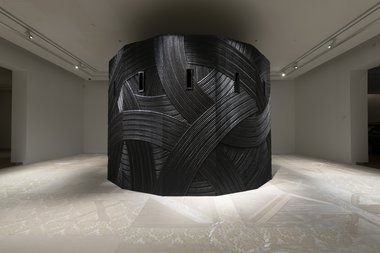
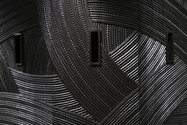
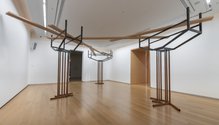
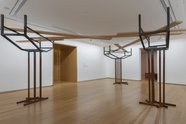


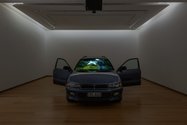
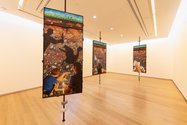
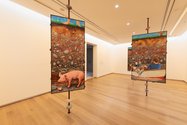
 Two Rooms presents a program of residencies and projects
Two Rooms presents a program of residencies and projects Advertising in this column
Advertising in this column



This Discussion has 3 comments.
Comment
John Hurrell, 11:42 p.m. 25 September, 2024 #
I notice that the 2024 Walters Prize judge, Bonaventure Soh Bejeng Ndikung, was wandering around the gallery today, looking closely at the work of the four contestants. Of course he is bound to have read the EC Handscomb Iti article alongside this. Wonder who he will pick?
Ralph Paine, 4:26 p.m. 27 September, 2024 #
Yeah, the “international judge,” along with all his proclaimed expertise and stature…
“Bonaventure Soh Bejeng Ndikung is a curator, author and biotechnologist, and is currently director and chief curator of Haus der Kulturen der Welt (HKW) in Berlin, Germany. He is the founder and was artistic director of SAVVY Contemporary in Berlin and was also the artistic director of sonsbeek20–24 – a quadrennial contemporary art exhibition in Arnhem, the Netherlands.”
Here’s sign of an extremely important techno-politico-economic dimension that Mr Handcomb’s essay fails to address adequately: globalisation—that is to say, the ongoing subsumption (as defined by Marx) of Aotearoa NZ by Capital. Hence: the Prize and its hosting institution are in no way “Pakehāising” forces, but rather globalising ones. The “international judge” is a bearer or agent of this force.
Given the Waitangi Process—a process directly coinciding with the era of globalisation—already the Prize and its hosting institution have been systematically involved in the formation of contemporary Māori art, yet this always in conjunction with a globalised/globalising regime of art, aka contemporary art. Hence: contemporary art is not Pakehā art.
It was precisely from within a growing awareness of the globalised/globalising regime of art that certain artists began insisting that they be named Māori artists. And that their artworks/art-work be named contemporary Māori art. Strategically, perhaps they had no choice but to do so; had no choice but to mark their collectively defined difference via attempts at rendering visible/audible/etc. certain territorialised group-feelings. Feelings formed locally by the experience of having grown up and now living as subsumed within this regime, including within the remnants of its imperialist and modern precursors: “Immersed in a new relationality, determined by the new global electronic mediation, the local appears to have lost its ontological moorings to become a social practice of the imagination … The theme of difference emerges from the fabric of the global production of locality.” (Marramao, ‘The Passage West: Philosophy After the Age of the Nation State,’ pp 30—31.)
Contemporary Māori art is today a glocally operational force possessing considerable mana. As a “social practice of the imagination” its allegorical/ideological potentialities (powers) are beyond doubt. However, given the accelerated devastation, corruption, and precarity that globalisation is forcing Contemporary Māori artists to endure, where are these potentialities heading? What is Contemporary Māori art becoming?
John Hurrell, 11:22 p.m. 27 September, 2024 #
Congratulations to Ana Iti, the winner of the 2024 Walters Prize. The judge is impressively eloquent in describing his admiration for this work--especially in regard to the multiple meanings of the title.
Participate
Register to Participate.
Sign in
Sign in to an existing account.